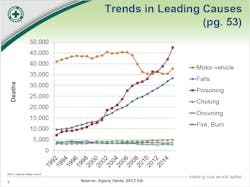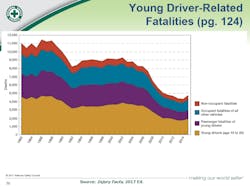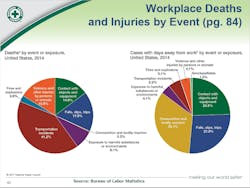Distracted Driving, Falls, Opioids Cause Spike in Unintentional Death Rate
The preventable death rate in the United States is increasing despite an overall improving fatality rate, according to the National Safety Council’s 2017 Injury Facts publication.
NSC’s latest Injury Fact report, which is published annually, examined unintentional injury data from 2015 and the causes and factors that played a role in the 7.7 percent increase in deaths from 2014.
“Since 1992, trends regarding unintentional injury deaths have been moving in the wrong direction,” said Ken Kolosh, NSC statistics manager. “The lack of improvement is resulting in real lives being lost.”
According to the NSC, the annual societal cost of preventable injuries is $886.4 billion, or the equivalent of about $2,800 per United States citizen. The per-person cost includes any direct, out-of-pocket expenses as well as higher costs for good and services and higher taxes.
“These are societal costs we all pay even if we are not personally impacted by one of these preventable injuries or deaths,” Kolosh said.
An estimated 58,000 fewer people would have died in 2015 if the preventable death rate had kept pace with the improving overall fatality rate, which has decreased 71 percent since 1900.
Three factors played a major role in the nearly 8 percent spike: poisoning, driven by prescription drugs and heroin deaths; slips, trips and falls, which directly correlates to an aging population and motor vehicle deaths due to distracted driving.
A reported 146,571 Americans died in 2015 from causes such as drug overdoses, motor vehicle crashes, falls, choking and drowning. Poisoning is the number one cause of unintentional death, according to the report.
Prescription opioids, heroin and benzodiazepines are the three most common substances in accidental poisoning deaths, whether used separately or in combination with one another. Overall, there has been a 456 percent increase in poisoning deaths since 1993, Kolosh said.
An aging 65-and-older population has caused a 182 percent increase in slip, trip and fall deaths since 1999.
"Older adults are now healthier and more active. So, they are at risk for fall-related injuries," he said.
In contrast with falls from higher levels, these falls typically are an event not immediately life threatening. However, prolonged down time because of incapacitating injuries and long medical stays could eventually result in death, Kolosh indicated.
Motor Vehicle Deaths
The Injury Facts report showed a dramatic 7 percent climb in motor vehicle deaths in 2015, largely attributed to distracted driving. However, there was a 3 percent increase in the number of miles Americans traveled year-over-year.
Motor vehicle deaths tend to increase as the economy improves, Kolosh said. In fact, preliminary estimates for 2016 show a second consecutive year of increasing deaths as well as increasing mileage-based death rates.
Total fatalities among drivers between the ages of 15 and 20 increased 9.7 percent from 2014 to 2015, according to the data. Motor vehicle accidents continue to be the leading cause of death for young drivers.
“Everyone who shares the road with young drivers are potentially impacted," Kolosh said.
Young drivers
Distracted driving remains a troubling factor to the rise in motor vehicle deaths, whether at home or in the workplace. Despite Injury Fact report data showing an 8.8 percent increase in distracted driving deaths, the actual number could be higher.
"It's very hard for a police officer to determine if distracted driving played a role in the crash," he said.
In the Workplace
Transportation incidents accounted for 41.2 percent of all workplace deaths in 2015, according to the Injury Facts report.
Overall, while workplace fatalities increased, the number of deaths is not rising as rapidly as incidents that happen at home or in the community. Unintentional injuries rose 1 percent in 2015, according to Injury Facts. In contrast, home and community deaths are up 6 percent.
The prevalence of workers experiencing short-sleep duration is growing, and fatigue is a common factor when examining the cause of unintentional injuries. About 13 percent of work injuries are related to sleep problems across all industries, Kolosh said.
The complete publication and facts are available on NSC's web site.



